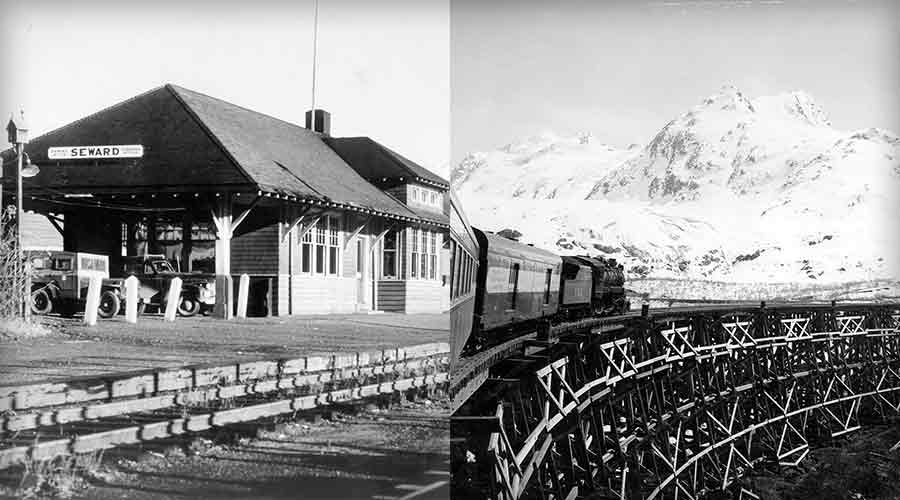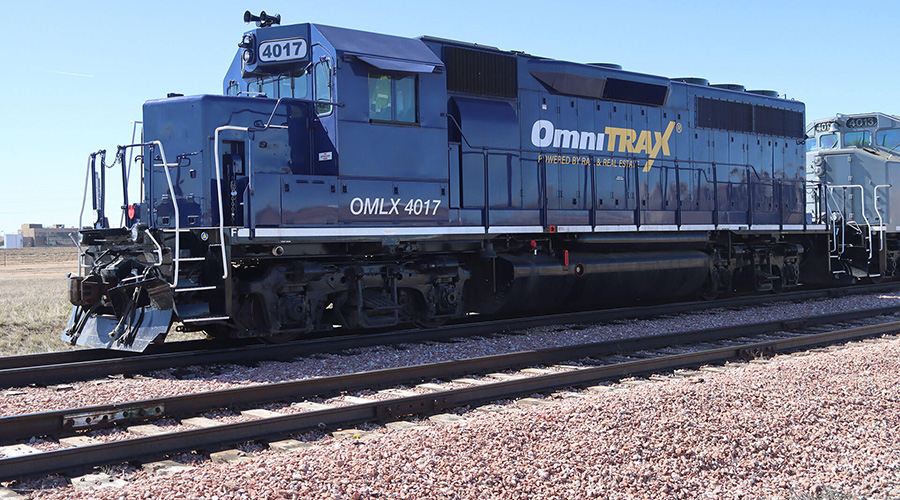At 100, Alaska Railroad in good health despite its age
8/4/2023
By Jeff Stagl, Managing Editor
On July 15, 1923, President Warren G. Harding drove a golden spike into the ground in Nenana, Alaska, to help mark the completion of the Alaska Railroad. But a little more than two weeks later, he grew ill and died.
Luckily, that didn’t turn out to be an ominous sign for the new railroad. Alaska Railroad Corp. (ARRC) just reached its 100th anniversary and, for the most part, has flourished over the course of a century.
ARRC held a ceremony July 15 in Nenana to commemorate the milestone. The event was attended by more than 800 people and included speeches by several dignitaries, including Alaska Gov. Mike Dunleavy, U.S. Sen. Dan Sullivan (R-Alaska), Federal Railroad Administrator Amit Bose, ARRC President and CEO Bill O’Leary and ARRC Chairman John Shivley.
Alaska leaders and residents consider the freight and passenger railroad a lifeline since it long has connected communities, helped foster economic growth and facilitated the movement of resources and people across the state.
“Alaska is, in many respects, about a railroad. Anchorage would not have existed without the railroad,” Dunleavy said at the ceremony. “Like Alaska, in and of itself, the railroad was all about promise, hope and opportunity. What is our state motto? North to the future. The railroad is a part of that.”
 President Warren G. Harding drove in a ceremonial gold spike in Nenana, Alaska, on July 15, 1923, to help mark the railroad’s completion. Alaska Railroad Corp.
President Warren G. Harding drove in a ceremonial gold spike in Nenana, Alaska, on July 15, 1923, to help mark the railroad’s completion. Alaska Railroad Corp. The U.S. government built the railroad between 1914 and 1923 to open the then-territory to development and move supplies throughout the large area more quickly and easily. The railroad’s route stretches from Alaska’s southern coast to its interior.
In 1985, Alaska leaders purchased the railroad from the federal government for nearly $22.3 million, and a state law mandates that ARRC be self-sustaining and responsible for its financial and legal obligations. As an independent corporation, ARRC is managed by a seven-member board appointed by the governor.
The railroad’s mission is to provide quality transportation and real estate services, operate profitably and foster economic development. Its real estate holdings total about 36,000 acres, including track beds, rights of way, facilities and yards (in Anchorage, Fairbanks, Seward and Whittier).
“What the railroad really stands for is service to Alaska and Alaskans. This organization is absolutely key to the state of Alaska,” said O’Leary at the ceremony.
ARRC now manages 656 miles of track, 682 freight cars and 45 passenger cars, and 51 locomotives, and employs more than 700 people, including seasonal workers. As of last year, the railroad’s assets were worth about $1.4 billion.
 In 1985, the state of Alaska purchased the railroad from the U.S. government for $22,271,000. Shown: State officials with a commemorative check. Alaska Railroad Corp.
In 1985, the state of Alaska purchased the railroad from the U.S. government for $22,271,000. Shown: State officials with a commemorative check. Alaska Railroad Corp. In 2022, the railroad generated $250.24 million in annual revenue and $39.2 million in net income, hauled 3.7 million tons of freight and transported 461,949 passengers. The railroad typically logs 500,000 passengers annually, but the pandemic severely reduced ridership, which hasn’t yet substantially recovered.
There have been many similar ups and downs for ARRC over the past 100 years. Here are some of them:
• 1930 — Anchorage, Fairbanks and Seward — the only sizable towns along the railroad’s route — couldn’t help generate enough business to make ARRC profitable.
• 1938 — Under the management of Col. Otto Ohlson, the railroad logged its first profitable year.
• 1940-1943 — During World War II, the railroad generated big profits by hauling military and civilian supplies and materials.
• 1944 — Whittier opened as a second railroad port and diesel locomotives begin to replace steam engines, a process that was completed in 1966.
• 1947 — ARRC’s Aurora streamliner made its inaugural run, launching upgraded passenger-rail service between Anchorage and Fairbanks.
• 1962 — The first car-barge service was established in Whittier followed by train-ship service in 1964. That enabled rail cars coming from the lower 48 states to reach any point along the railroad.
• 1964 — The Good Friday Earthquake struck Alaska on March 27 as the most powerful quake recorded in North America history. Damage on the railroad totaled an estimated $30 million, but ARRC was able to restore freight service from Anchorage to Fairbanks by April 6, passenger service by April 11 and freight service to Whittier by April 20.
• 1975-1979 — The Federal Railroad Administration sought to transfer its ownership of the railroad via a sale, transfer or dissolution, which fostered an infrastructure-poor and equipment-strapped period as investments declined while options were mulled.
• 1983 — President Ronald Reagan signed legislation authorizing the transfer of the railroad to the state of Alaska, and in 1985 it became the property of the state.
 On Good Friday — March 27 — in 1964, the most powerful earthquake in North American history struck Anchorage. ARRC suffered infrastructure damage costing about $30 million. Alaska Railroad Corp.
On Good Friday — March 27 — in 1964, the most powerful earthquake in North American history struck Anchorage. ARRC suffered infrastructure damage costing about $30 million. Alaska Railroad Corp. • 1986 — A once-in-100-years flood destroyed two major bridges and several smaller bridges, and covered tracks in mud, causing about $3 million worth of damage, but service was restored in 13 days.
• 1988 — A new depot was constructed at Denali National Park and Preserve, a popular summer destination for visitors.
• 1991 — Frank Turpin retired as the railroad’s first president and CEO, and Robert Hatfield Jr. — a 17-year veteran of Southern Pacific Transportation Co. — was installed as his successor.
• 1995 — Annual ridership reached a high of 500,000 and former Alaska Gov. Bill Sheffield was elected chairman. \
• 1997 — A program was developed to build new depots and docks, improve rail infrastructure and modernize via technology, and former Alaska Gov. Bill Sheffield became president and CEO while John Binkley became chairman.
• 2000 — The railroad initiated the Grandview passenger train to transport cruise ship passengers between Seward and Anchorage.
• 2001 — Sheffield retired and Patrick Gamble, a former four-star Air Force general, was appointed president and CEO.
• 2005 — The railroad introduced a new GoldStar class of passenger service featuring two new double-deck luxury cars and became the first U.S. railroad to be granted approval to transport liquefied natural gas by rail.
• 2010 — Rail industry veteran Christopher Aadnesen was named president and CEO.
 Shown: A passenger depot in Seward and an ARRC train traveling through the Loop in a mountainous area during the 1940s. The Loop enabled trains to navigate a steep grade. Alaska Railroad Corp.
Shown: A passenger depot in Seward and an ARRC train traveling through the Loop in a mountainous area during the 1940s. The Loop enabled trains to navigate a steep grade. Alaska Railroad Corp. • 2011 — ARRC broke on the Tanana River Crossing to accommodate year-round access by the military to the nation’s largest training grounds. The project was completed in 2014.
• 2013 — Bill O’Leary was appointed president and CEO, becoming the first lifelong Alaskan to lead the railroad.
• 2018 — The railroad dealt with another strong earthquake, this time one with a magnitude of 7.0 that struck near Anchorage on Nov. 30.
• 2020 — ARRC posted a net loss of $7.8 million on total revenue of $150.7 million due to pandemic-related challenges.
• 2022 — The railroad experienced a cybersecurity incident when a third party gained unauthorized access to the railroad’s internal data network.
In the near future, a new cruise passenger dock, new passenger terminal facilities and associated upland improvements are slated for completion at ARRC’s Seward land reserve to offer more opportunities to cruise lines. By keeping improvements and investments ongoing, the railroad figures to keep playing a key role for the state’s industries and residents for many years to come, ARRC leaders believe.
“Throughout the decades, the railroad has been a critical pillar in transporting goods and supplies, contributing significantly to development all along the railbelt,” they say.


